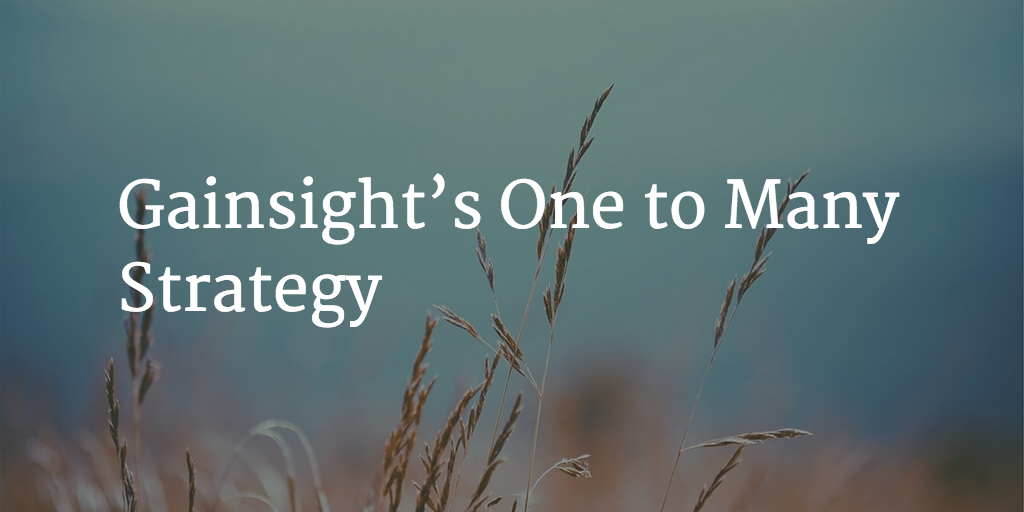Allison Pickens is VP of Customer Success & Business Operations at Gainsight
- “My CSMs are overworked.”
- “They spend a ton of time on repetitive activities, but we’re not sure how to automate those.”
- “We want to email segments of our customers, but we can’t get access to the email automation system because Marketing manages it.”
These are common refrains among Customer Success teams. To address these challenges at Gainsight, our CSM team often engages with our customers through a 1:many method (i.e. 1 communication reaches many customers). This blog post will focus on one tactic in a 1:many program: email. At Gainsight we use CoPilot, our email automation functionality, for this purpose.
In this blog post, I’ll cover 3 topics related to 1:many Communications:
- Strategy
- People
- Process
1. Strategy
Your 1:many strategy should start with a strong understanding of your Customer Lifecycle. From there, you can pinpoint the role of 1:many communications.
As you’ll see in the diagram below, we have 4 stages in our Lifecycle. To guide customers along the right journey, we use 2 approaches:
- CSM Touches: 1:1 interactions between the CSM and the customer. They lay the groundwork for the customer relationship.
- Tech Touches: Provide air cover for the CSM in two ways: first, by “warming up” the customer to certain concepts, thus enhancing the value of subsequent 1:1 interactions; and second, by replacing certain 1:1 interactions.
We use Calls to Action (CTAs) in Cockpit to remind the CSM when to reach out at critical points in the customer lifecycle. We use CoPilot for Tech Touches.
Let’s walk through how we use Tech Touches to complement CSM Touches.
To execute your own Lifecycle Strategy using Gainsight, we recommend filling out a spreadsheet like the one below. You can also contact your CSM to get a copy of the Google doc that we use. Once you complete and share the table with your team, every CSM will know when they should expect to receive certain CTAs, and when their customers will receive certain 1:many communications.
I’d recommend creating a table for each of your customer segments. You’ll likely rely on 1:many communications more for your lower-touch customers, as well as for other customers for whom you have a highly standardized customer lifecycle.
Look for 2 signals when carving out a role for 1:many outreaches:
a. The CSM is performing a repetitive activity that guides the customer along the right journey.
At the end of each day of the onboarding workshop that I mentioned in a previous post, we send customers a 1:many email that describes what they implemented that day and how to roll it out to their team. This helps us boost adoption early in onboarding. Despite the usefulness of this content, I’d prefer that the CSM didn’t spend their time copying the same email template a dozen times.
b. Customer has already strayed from the prescribed journey.
When a customer’s adoption of a particular feature is low, they receive an automated email from us with content on the value of that feature and best practices for using it.
2. People
Despite how magical our communication strategy may seem, our 1:many outreaches don’t come out of the ether. We have a dedicated 1:Many Communications lead (a member of the Customer Success organization) who designs and executes these Tech Touches.
This team member is responsible for contributing to the attainment of key metrics for the customer segment(s) they support:
- Time to value (i.e. time in onboarding)
- Adoption
- Net Promoter Score
- Gross retention
- Upsell rate
- Accounts per CSM (since effective 1:many activities should free up time for CSMs to manage more customers)
The 1:many lead should cover the following activities (including but not limited to managing email outreaches):
Design and implement a Lifecycle Strategy
- Design the lifecycle stages, cadence of Tech Touches, and when CSMs should reach out, for each customer tier, to create a comprehensive engagement program
- Segment the customer base and target content to the right segments to ensure high relevance
- Determine how various forms of 1:many outreach (emails, webinars, videos, NPS surveys, Community, support hub, etc.) should all work together
- Operate those tools to support the CSM team’s goals of driving key metrics, including time-to-value, adoption, NPS, retention, up-sell, and accounts per CSM
- Define success metrics, to test and optimize the Lifecycle Strategy
Schedule automated outreaches, in accordance with that strategy
- Manage CoPilot (email automation product in Gainsight)
- Craft effective email templates
- Automate as much of his/her job as possible by scheduling ongoing outreaches to be distributed automatically
Collaborate cross-functionally to:
- Source content from the Customer Success, Training, and Product teams
- Coordinate outreaches to customers with the Marketing team, which may contact customers about advocacy opportunities or brand-related topics. Could involve maintaining a communications calendar
Manage your NPS survey program
- Determine the frequency of surveys
- Use the survey functionality within Gainsight to distribute them
- Use dashboards to analyze quantitative results (e.g. how does NPS vary across personas, such as executive sponsors and system administrators)
- Summarize qualitative feedback and share with other departments
Some companies have a full team of 1:many communications managers that focus on a Tech-Touch-Only segment of customers (i.e. that have no 1:1 interactions with CSMs). Companies that are small or that don’t have this type of segment may hire a single 1:Many lead to complement CSM Touches across the customer base.
Note that this role reports into Customer Success, not Marketing. We’ve divided responsibilities as follows:
- Activities that drive the CSM team’s metrics (above) are handled by the CSM team. We use CoPilot for email outreaches.
- Activities that drive new business (top-of-the-funnel, new deals) are handled by Marketing or Sales. Marketing and Sales use other email automation solutions.
3. Process
Your process will need to address a few questions:
1. How do CSMs know what emails their customers have received?
We built a table in the Customer360 dashboard for each customer that summarizes the emails they’ve received. If the CSM notices that the customer hasn’t opened a particular email even though the topic is critical for them, they can re-send the content with a customized note.
2. In what circumstances would it make sense for the CSM, rather than the 1:many lead, to send emails through CoPilot?
We try to send as many outreaches as possible through our 1:many lead, since this is more efficient than each CSM sending their own. However, certain situations warrant the CSM taking the lead, e.g.:
- CSM is traveling to a particular city and wants to schedule meetings with customers only in that area
- CSM reminds customers of his/her upcoming vacation
- CSM wants to “go above and beyond” by sending content to his/her customer base – for example, about a product release.
3. How do you know whether your 1:Many communications strategy is successful?
- Keep an eye on email performance metrics: open rate and click rate. A/B test your templates by sending one template to half your customer base and another template to the other half; see which performs better.
- As you become more advanced, you’ll want to see which emails are most effective in driving milestone attainment and adoption.
If you have questions about how to implement your own 1:Many Strategy, feel free to reach out to your Gainsight CSM or to Allison at apickens@gainsight.com. You can also follow Allison’s blog posts on Twitter at @PickensAllison.






